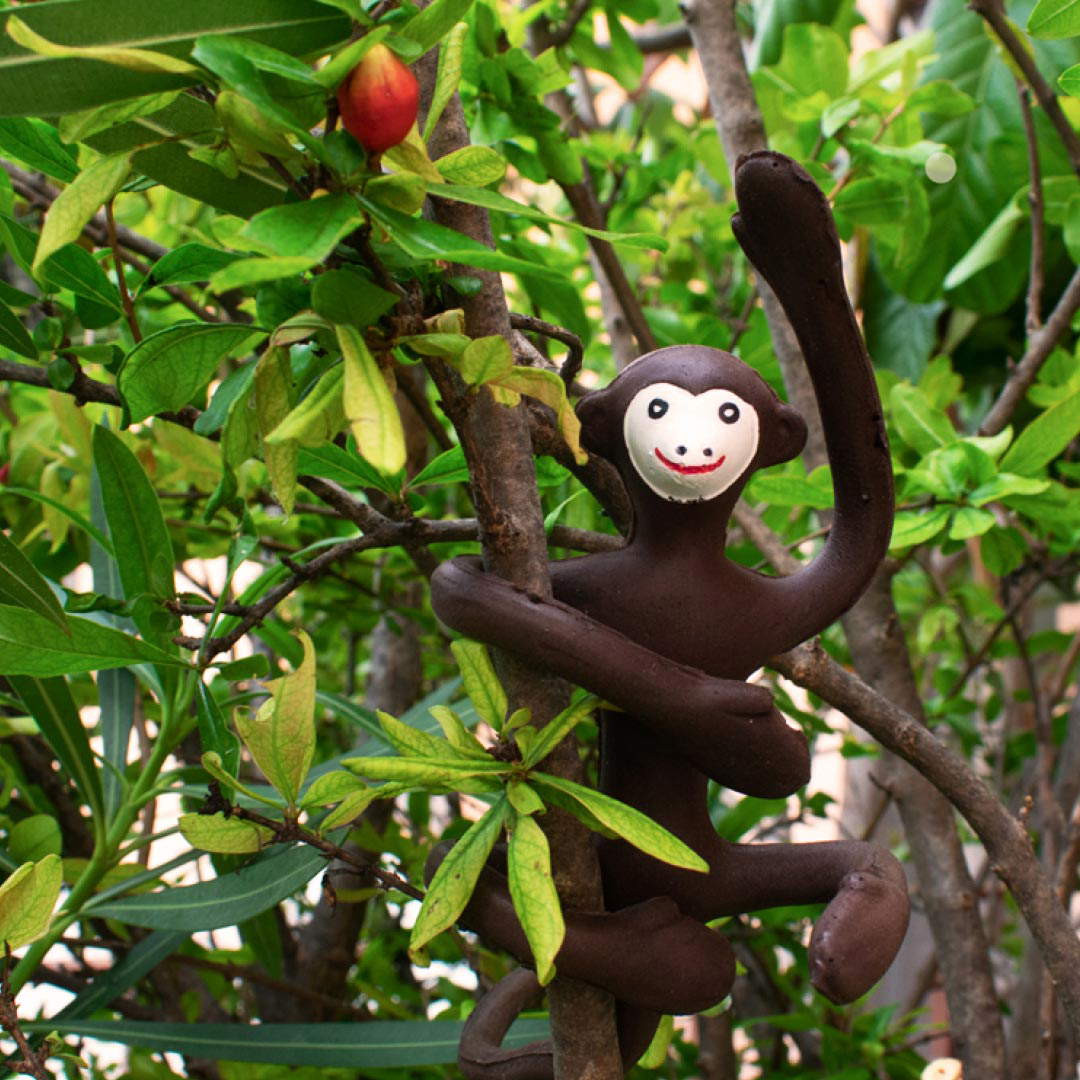Would you believe that a monkey won a Compasso d’Oro? No, if the phrase is taken literally. Yes, however, if the monkey is the creation of one of history’s greatest designers. 1954, the first edition of the award that recognizes the best design objects: among the winners is the Zizì Monkey, a creature by Bruno Munari (Milan, 1907 - 1998), destined to become one of the most famous and controversial toys in history. The little monkey was made of armored foam rubber and had a minimalist look, characterized by clean lines and simple shapes. Brown with a smiling white face, long arms and a very long tail: this was how Zizì looked.
What made the monkey unique was its versatility and the fact that it could be shaped and manipulated into different positions, thanks to the presence of a wire core that made it a flexible toy that could be bent, rotated and adapted into various shapes. This feature allowed children to exercise their creativity and imagination, imagining the monkey in many different positions. It was something very original for the times. The same could be said of the packaging: a kind of cage to be opened to free Zizì.



The story of the little monkey begins in the late 1940s: foam rubber (the name by which elastic polyurethane foam is commonly known) had been born relatively recently, in 1929, and in the postwar period the industry began to explore its uses in a systematic way. Munari at the time was commissioned by Pirelli to find new and alternative uses for foam rubber, a material the company had been using since the 1930s. Munari’s idea was to use weaponized foam rubber (that is, with jointed wire inside) to create toys. “I had some samples of this new material given to me,” the designer himself would later recount, “and I began an experiment to see what other things could be designed so that the designed object would be consistent with the material and its qualities. The most obvious quality was manifested through touch. Any piece of foam rubber, manipulated by a child, communicates the softness, the elasticity of the material that feels alive and that, to a child, brings to mind the same feeling as holding a kitten or a small animal.” The first toy, created in 1949, was the Meo Romeo cat, followed in 1952 by the even more essential Zizì monkey. And what was supposed to be a kind of demonstration of the potential of material became the product of a “philosopher,” as Pablo Picasso would have said according to a recurring anecdote.
The impact of the little primate was immediately recognized. This was the motivation with which the toy was awarded the Compasso d’Oro: “Normally toys are ’veristic’ or infantilized reductions of mechanical means, or equally veristic, or infantilistically ironized, imitations of animals or human figures. Instead, this small quadrumane by Munari, published by Pigomma, to which the 1954 La Rinascente Compasso d’oro Award is attributed, represents an interpretation of the character of the ’character,’ which has achieved a formal essentiality, in the typical use of the material, foam rubber articulated by a steel wire armor, which allows for the enjoyment of an infinity of attitudes. This toy belongs to a high category, which has made it the object of intellectual interest.”




Munari’s main concern was to make the toy manipulable by the child: for him, a toy is not just made to be looked at. In fact, Munari firmly believed that design should go beyond aesthetics and serve as a vehicle to stimulate creativity and imagination. Hence, then, the idea that design could also be a tool for education. Munari created children’s books, games and interactive toys designed to engage young readers and teach them to think creatively. He stressed the importance of introducing art and design from an early age to stimulate intellectual and creative development. Besides, Munari was known for his experimental attitude in design. He constantly sought new solutions and approaches, pushing the boundaries of traditional conventions. This aptitude for experimentation enabled him to create innovative works and products that challenged expectations and stimulated the imagination of viewers and users. The Zizì monkey is one such object, and it has thus become an icon of Italian design and remains to this day a cult object for design enthusiasts and collectors. Its essential design and its ability to inspire children’s creativity demonstrate the importance of Bruno Munari’s work in the field of design and creative play.
Originally produced by Pigomma, in 1997 it was slightly revised by Munari himself to be reissued in 2001 by the Design and Furniture Gallery. Today, however, the rights have been taken over by Corraini Edizioni of Mantua, which has reconditioned a series of hand-painted Zizì monkeys produced in 2007 by Tecnoassemblaggi Toys of Brescia, putting them back on the market in 2022 at a cost of 60 euros each, also re-proposing the original packaging with the cage motif. This is why Corraini warns that “Zizì is not a toy, but a modern collector’s item,” since the specimens are fragile and not without flaws, attributable to the age of the object. A negligible element if you want to have in your home an object that made the history of Italian design.
Warning: the translation into English of the original Italian article was created using automatic tools. We undertake to review all articles, but we do not guarantee the total absence of inaccuracies in the translation due to the program. You can find the original by clicking on the ITA button. If you find any mistake,please contact us.